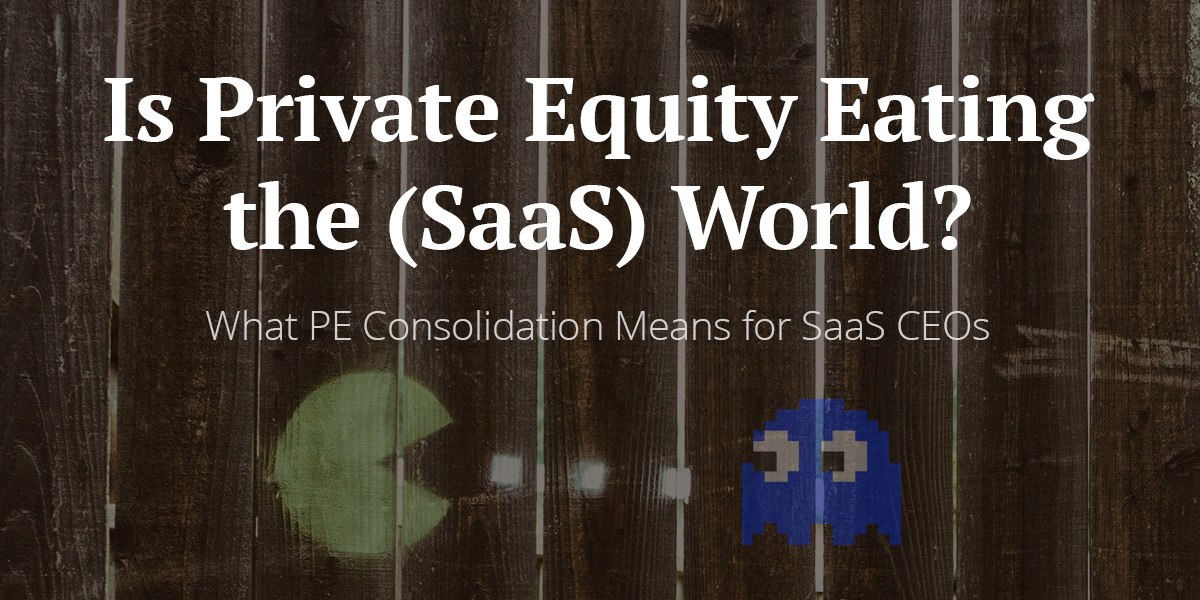TCV General Partner Dave Yuan is an old friend and colleague. We actually first met in college, but over the years I’ve turned to him for insight and advice. When we reconnected last week I was particularly struck by his perspective on private equity investments and got his permission to share our conversation.
Nick: How long has it been since we grabbed drinks last?
Dave: I think about five months.
Nick: Wow – that’s it? The last time we chatted, it felt like the sky was falling. SaaS was dead, and VCs’ blogs all made me feel like it was time to go back to my mother’s advice and become a doctor. Now, between strategic M&A, Private Equity purchases, and a re-opened IPO window, it’s raining exits!
Dave: Yeah, the valley doesn’t do moderation well, does it? From the sky/LinkedIn is falling to LinkedIn the 3rd largest tech acquisition of all time. We’re a pretty comical bunch.
In reality though, I don’t think there’s much that’s new here. The IPO window never actually closed. Rather, valuation parameters changed as did relative weights of growth versus profitability. SaaS venture money never died, but rather the bar got higher and weights shifted with the public market. By the way, I believe this is still the case, and hope it stays for a while as it leads to healthier SaaS companies. M&A has picked up as large incumbents who were on the sidelines have come back in as multiples have come back closer to longer-term norms.
What I do think is new is the nature and strategies of the private equity buyers.
Nick: Who are these new buyers? All of a sudden public SaaS companies are being taken private by firms I haven’t heard of before.
Dave: Well, private equity in software actually isn’t new. Folks like Golden Gate Capital have been in software for over a decade. But their strategy was different. I’m paraphrasing, but their approach was really focused around the insight that maintenance revenues are really sticky. So their playbook was to buy mature companies (e.g. usually slow growing) with high maintenance revenues where you could raise prices and see little churn and cut costs on sales, marketing, and development. The net effect was to dramatically change EBITDA (earnings before interest taxes, depreciation, and amortization) margins. They would also use some financial engineering in the background to juice their returns and give them the capacity to acquire and integrate other companies and reduce duplicative overhead. Private equity has actually aggregated massive software revenues very successfully through this strategy.
Nick: But the recent software acquisitions seem pretty different.
Dave: Right. Recent SaaS PE deals are different. At more than six times revenues, unless you can increase EBITDA margins to over 40%, it’s hard to get your arms around the effective EBITDA multiple. It seems the new breed of PE buyer is taking a bet that SaasS companies will exit on revenue multiples and show rapid growth over many years. Both are arguably new bets for private equity. It’s not about financial or cost engineering. They are starting to look a bit more like us in the growth investing industry and taking a bet on category leadership and growth.
Nick: Why is this a big deal? Everyone knows that SaaS companies trade on revenue, not EBITDA.
Dave: Well, revenue multiples are accepted in early stage and growth equity. However, in private equity, it’s a little different. Think about it. If you’re an early stage investor investing $3 million in a senior preferred security, it’s different investing $300 million of equity that’s under $500 million in debt.
Nick: Sorry your financial mumbo jumbo lost me.
Dave: Sorry. Let’s use an example. If you’re a venture investor investing in a $3 million senior preferred security, because you are senior, you aren’t going to lose money unless that company is worth less than $3 million. Now, in the case of private equity, let’s say they buy a company for $800 million with $500 million of debt from lenders and $300 million of their equity. If the company is worth $1 less than $800 million, you lose a dollar. In fact, your $300 million is worth nothing unless the company is worth more the $500 million you borrowed.
Nick: Ok, I think I’m starting to get it.
Dave: So while revenue multiples are accepted, they are viewed as risky by private equity. Take Salesforce.com, the bellwether of SaaS. Over the last 10 years, it’s traded below 2 times next-twelve-months (NTM) revenues and over 10 times NTM revenues. Even in the past 12 months, it’s traded as low as 4.7 times NTM multiples and as high as close to 9 times NTM multiples. In this example, if the private equity firm paid 9 times NTM revenues and multiples traded down to 4.7 times NTM, their $300 million in equity would be wiped out. In fact, they would owe the bank close to $100 million. Now it’s not that bad, as these companies are growing revenue at the same time. But it does show you why private equity has largely been wary of revenue multiples and have relied on EBITDA and free cash flow multiples.
Nick: Do these investors know what they are doing? Is this a passing fad?
Dave: I’m going to give you another one of my “hard to say” answers. I do think these guys know what they are doing. Some of the smartest people I’ve met in investing are private equity buyers. But I think it all depends if they these bets pay off – if they make money. They are certainly taking different and perhaps new risk, but if it pays out other private equity will follow. So I’d say it’s certainly here to stay for the short and mid-term. Five years from now, it all depends if they make money.
Nick: So, as a growth SaaS company should I pay any attention to these PE firms?
Dave: I think so. Private equity has been able to outbid strategics in some recent transactions, so it would be foolish not to. As you know, an auction dynamic drives price, and having another credible and aggressive bidder in the mix can make all the difference in the world.
Price aside, there’s some real advantages to private equity: they care less about the qualitative and more about the financial profile. You don’t have to be No.1 in a category as long as they think you can post good growth and potential profitability. Size isn’t an issue. The reality is only a few strategics can write a $1 billion check. Many PE firms can do a $1 billion transaction. They are deal machines. The reality is strategics are fickle. They can go hot and cold very quickly if a key executive leaves, if they experience any changes in their performance, if capital markets change, or if they’ve done big deals. Some strategics will go dark for major periods of time and won’t even look at the most obvious acquisitions. PE firms aren’t like that. They are generally always in business and if the model works and they like the business, they will transact. They move quickly. PE firms are in the business of doing deals, and they can move quickly.
You should also be aware when one of these players enters your market or an adjacent space. By nature, a private equity owned company can be acquisitive, so they may alter the industry structure and competitive dynamic with their buying activity.
Nick: Should I engage with these firms if they reach out?
Dave: Absolutely. Do what you do with strategics, which is to build a relationship over time. Stay on their radar screens. PE firms are deal machines, but trust and relationships matter. Each deal champion is taking a big personal risk in buying a business and understanding the company’s thinking, and engaging with a CEO over time can make a big difference. I know that in many of my deals I’ve known the CEO for over two years before investing. It’s a big deal.
Nick: That really resonates with me regarding having more companies in your ecosystem. At my last company, LiveOffice, when we received an offer from Symantec, we were excited about the strategic fit for our clients and team. But we didn’t have a lot of leverage, since in our ecosystem, there was really just one buyer, and we were subscale to go public. Hence the deal was a good return for everyone involved but the multiple, 4.5 times revenue, wasn’t a big premium.
At that moment, I realized that as a CEO, you put so much time into growing your team, company, customers, etc. and yet when it comes down to it, the end value of the company is an equal mix of the business value and the strategic value.
It’s obvious to say, but hard to internalize until you’ve been through it, that having two or more potential buyers is radically better than having one. So it’s great to see PE firms get active in SaaS.
Dave: Well said.
Nick: Ok, glad I got another thing to worry about during nights and weekends. How do I speak private equity-ease? Do I need to carry around a money clip with $100 bills and pretend to have a house on Necker Island?
Dave: Dude, you’re speaking to a pseudo private equity guy. At TCV we do both VC deals and buyouts. Although, I have to admit I don’t know where Necker Island is.
Know your audience. Pitch everything you do to a VC. The qualitative: market size, market structure, competitive advantage, execution, and team. But also link it to financial metrics like sales and marketing efficiency, retention, and gross margins that are key drivers of the business model. It’s actually probably worth doing a buyout model of your business. It won’t be perfect, but it will start highlighting the key levers that you should speak to. The best investors are always mapping the qualitative feedback to a mental model of returns. Not only will you be able to talk to model heads like me, but you may also learn something about your business.
You’ll be fine. Just wear your shiniest pocket square, and be careful about your Patriots disses. Pats fans are everywhere.
Nick: I always learn something from you, Dave. Thanks for this! Next topic for next time: how does it feel to have Voldemort as your favorite football team’s coach? And is it true that all Pats players drink unicorn blood? I’ve heard that’s Gronk’s secret.
Dave: Let’s talk October 24th.

